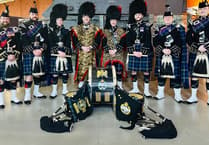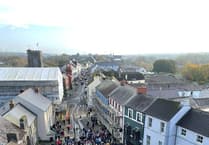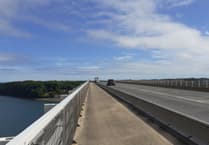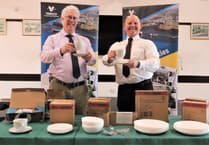Pembroke WW1 Project
In February, we launched the Pembroke WW1 Project in an attempt to gather information and research the impact of the Great War on Pembroke and surrounding area. With Remembrance Sunday approaching, it was appropriate that we held a follow up event on Saturday, November 1, to bring you up to date with our progress, and this event was again supported by Pembroke Town Council. During the course of this year, we have put together an exhibition of photographs in Pembroke Town Hall and on Saturday this was supplemented with displays from other Heritage groups - the Royal Artillery Association, Pembroke Civic Trust, West Wales Maritime Heritage Society and the Dyfed Archaeological Trust.
It was a busy morning with two speakers - George Lewis, president of our society, and Alice Piper from the Dyfed Archaeological Trust (DAT).
Painters of the War
Beginning proceedings, George Lewis spoke on the subject of the Painters of WW1. A popular speaker, George is an amazing font of knowledge and gives talks on a wide variety of subjects - last week he was talking to Pembroke Civic Trust on the history of the Pembroke and Tenby Railway! However, art is his main love and expertise: he and his wife Jeanne painted the amazing Pembroke murals which adorn the walls of Pembroke Town Hall and which illustrate our history from earliest times to the Edwardian era.
George gave a comprehensive talk on paintings produced during the period of the Great War. He began by looking at techniques and artistic movements of the time which were influencing new ways of representation. As well as independent painters, official war artists were appointed to record the war - many of the paintings produced from sketches and material gathered during the visits to the various campaigns or supporting activity such as munitions factories, hospitals and civilian situations. The talk was illustrated by a great many slides of these paintings which were fascinating, the grim reality of war seen through the eyes of the artist.
The Legacy
of the War
After a break and refreshments served by the hardworking ladies of our committee (our society is always hospitable!), we were addressed by Alice Piper, of Dyfed Archaeological Trust. Alice came all the way from Llandeilo to speak to us and to ask for our help in the research project the Trust is presently engaged in. The impact of the war was huge. There was mass recruitment, mobilisation and training of men and women across the country. Industries were adapted or expanded - the whole country geared up to contribute to the war effort. We are left with the physical remains - buildings, landscapes and artefacts. During these centenary years, Alice is asking help from us all in identifying sites that relate to WW1 and to record them. You can contact DAT direct on http://www.dyfedarchaeology.org.uk">www.dyfedarchaeology.org.uk or contact Pembroke and Monkton Local History Society.
Our Exhibition
For example, thanks to contributions of your stories and photographs, we have a lovely collection of photographs and information on the military hospital at Llanion. John Russell has contributed photographs taken by his father in law, Ted Jay, who was a Despatch Rider in 1914 stationed at the Defensible Barracks, Pembroke Dock. Printed here is a photograph which he took of soldiers under canvas at Holyland Camp, so important as it is the only one we have of that camp. Please keep them coming. Although we shall be taking down the exhibition in Pembroke Town Hall (in the main hall) towards the end of this month, we will be continuing the project and all the photographs will be available for you to see in the museum.
I shall now print here a story written by Vicki Haggar and concerns one WW1 memorial which can be seen in St Mary's Church.
The Cottage
by the Castle
"One very poignant story that I must relate was passed on to me by Diana Rees and her sister Maggie Haggar, both originally from Angle and daughters of the late Herbie Rees. of Carters Green Farm.
"In 1905, Diana and Margaret's grandfather George Paish, who was an R.S.M. in the Welch Regiment, was posted from Maindy Camp in Cardiff to Pembroke to train the Yeomanry at Penally Camp. Being a Bisley Shot, George was famed throughout the military for his skill as a marksman; the Army's finest crack shot. It was felt the weaknesses in performance of the troops in the Boer War was indicative that further training in manoeuvre and the use of weaponry was required. It was George's mission to set-up the Penally ranges and apply his skills as a firearms accuracy instructor to ensure that the bullet always hit the target. George installed a rigorous training programme at Penally shooting range.
"Meanwhile, a cottage was made ready for R.S.M. Paish, his wife Annie and their three children, William, Dorothy and Dick, right next to Pembroke Castle. It is thought that it may have been the ticket office cottage. A bath was installed in the cottage. This was the first household bath in Pembroke and there were frequent callers at the door 'Please can we see the bath ?' Also, due to the fact that R.S.M. Paish had served in India with the Welch Regiment and, consequently, was very partial to curry and other strange spicy food unknown in Pembroke 'Please can I smell the curry?' was another popular request. At this time the Castle was open ground and R.S.M. Paish's wife Annie used to keep her chickens there.
"Their daughter, Dorothy, Diana and Margaret's mother, was born in Maindy barracks in 1902. She started school at Pembroke's East End School in 1907. Dorothy had a pony which she kept on the Commons near Monkton Bridge. Every school morning, she would ride along the Commons to Gooses Lane, tie up her pony in East End Parkland, go to school and after school pick up her pony and make the return journey back to the Monkton Bridge fields and then home to the cottage.
William Paish
"Dorothy's elder brother William was born in India and later attended Pembroke Dock County School. William, having attended Netherhall music academy where he was maestro on the flute and could play every musical instrument. His skills were put to good use in his army career. William was a choirboy at St. Mary's Church, Pembroke, when he joined the 17th Lancers and experienced the Irish uprising. The next posting was to France with his regiment where, sadly, he was shot and killed at the Battle of Amiens on August 8, 1918. He was just 23 years of age. William's parents had a plaque erected on the wall in St. Mary's Church to remember their son William Paish. He is buried at Manitoba Cemetery, Caix, France.
"In 1915, the family moved to Angle where Annie ran The Globe Hotel whilst George continued his army career. It was at The Globe that the Telegram arrived announcing William's death. On his retirement from the army, George and Annie left The Globe and took over Coreside Farm at Rhoscrowther, but George never forgot his son William; truly a son after his own heart."
November events
Friday, November 21, 7.30 pm, at Monkton Priory Church Hall quiz night and social - £4 includes buffet. Bring your own bottle if you wish.
The next Civic Trust Talk will take place on Monday, November 17, 7.30 pm, at the Power Club, Main Street, Pembroke. 'Through the Years' by Frank Harries.
Contact
If you have any stories, photographs or feedback for this column, please contact me, Linda Asman, on 01646 622428, email [email protected]">[email protected] and visit our website http://www.pembrokeandmonkonhistory.org.uk">www.pembrokeandmonkonhistory.org.uk




